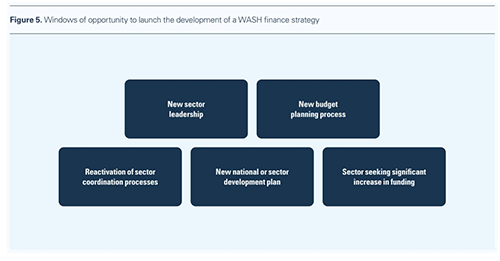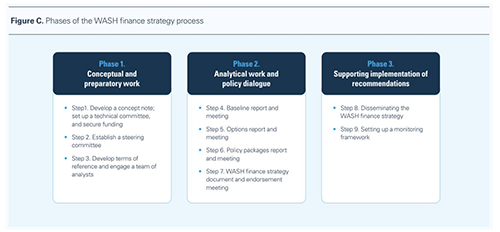UNICEF has published a guide which shows how to rally stakeholders to close the finance gap to achieve SDG 6.
The guide outlines key elements of a finance strategy, showcases the benefits of investing time and resources to properly understand WASH finance, and explores the preconditions needed for the strategy to be useful.
By Guy Hutton, Senior Adviser, Water, Sanitation and Hygiene, UNICEF New York, and Roberto Martin Hurtado, UNICEF Consultant
When the SDGs were adopted in 2015, the international community recognized that closing the finance gap to achieve water, sanitation, and hygiene (WASH) targets is a major ask. At the time, the USD 114 billion needed to cover the capital costs of universal access would have required a threefold increase in spending. This number also did not take into account the funding required to operate and maintain WASH systems, replace ageing infrastructure, and ensure smooth running of the sector as a whole.
Why is a WASH finance strategy necessary?
Since 2016, there has been no observable increase in WASH sector financing globally, even if more is being spent in some countries, according to UN GLAAS data which will be released later this year. In 2019, 20 countries and territories reported a finance gap of 61% between identified needs and available finance to reach national WASH targets.
Cost recovery from user charges has not significantly increased in the past decade, and in more than half of countries, tariffs are still insufficient to cover at least 80% of operation and maintenance costs. While official development assistance (ODA) grants for WASH have been at a standstill in real terms since the year 2000, ODA loans have been steadily rising. Today there is also evidence of more climate, innovative, and private sector sources being tapped, giving hope for the future financing of WASH targets.
Based on this realistic outlook, it is vital to adopt a strategic approach to closing the WASH finance gap. This means understanding financial flows and needs, viewing the performance of existing fund flows through the lens of equity, effectiveness, and efficiency, finding ways to use the funds more efficiently, and establishing measures to attract additional financial resources.
How can we successfully close the financing gap?
In September 2022, the UN Children’s Fund (UNICEF), with the support of the Agence Française de Développement (AFD), the IRC Water and Sanitation Centre in the Netherlands and the Sanitation and Water for All (SWA) partnership, launched a comprehensive guide to developing a WASH finance strategy.
A WASH finance strategy assesses the sector finance gap over a long planning period, identifies options to mobilize more financial resources and reduce the costs of achieving sector targets, and provides policy recommendations to close the finance gap.
The guide will support governments and development partners to promote and facilitate the development of WASH finance strategies. This process requires policy dialogues and consensus building by asking difficult questions about the best ways to achieve WASH goals. Above all, a WASH finance strategy should not operate in a vacuum. Instead, it should be opportunity-driven and linked to existing processes (see Figure 5).

What’s in the Guide?
The guide outlines key elements of a finance strategy (see Figure A), showcases the benefits of investing time and resources to properly understand WASH finance (see Figure B), and explores the preconditions needed for the strategy to be useful.

Because many previous WASH finance plans or strategies have not had the needed impact, the guide also explains which resources are required in order for strategies to be successful. Additionally, the guide offers advice on engaging the right stakeholders and producing relevant analyses to support policy dialogue (see Figure C).

The final section of the guide covers the main contents of a WASH finance strategy, including the 3Ts framework (taxes, tariffs, and transfers), the data requirements and methods of analysis to estimate the financing gap, and ways to assess implications of different sources of finance.
The guide also provides case studies from countries which have successfully used finance-related strategies and instruments in the recent past – including Albania, Armenia, Cambodia, Ethiopia, Kenya, Mali, Morocco, Myanmar, Rwanda, and Senegal. These examples emphasize government leadership and the supportive collaboration of sector agencies.
The guide is available in English, French, and Spanish. Articles are also available from SWA and IRC.